The Effect of Temperature and Humidity on the Filtration Performance of Electret Melt-Blown Nonwovens
Abstract
1. Introduction
2. Materials and Methods
2.1. Materials
2.2. Preparation of Melt-Blown Nonwoven
2.3. Heat and Heat-Moisture Treatment of Melt-Blown Nonwovens
2.4. Characterization
3. Results
3.1. Structure and Performance of the Melt-Blown Nonwovens
3.2. Relationship between the Filtration Performance and Air Flow Rate
3.3. Relationship between the Filtration Performance and the Heat Treatment Conditions
3.4. Attenuation of Surface Potential
4. Conclusions
Author Contributions
Funding
Acknowledgments
Conflicts of Interest
References
- Feng, S.; Gao, D.; Liao, F.; Zhou, F.; Wang, X. The Health Effects of Ambient Pm2.5 and Potential Mechanisms. Ecotoxicol. Environ. Saf. 2016, 128, 67–74. [Google Scholar] [CrossRef] [PubMed]
- Chen, Z.; Wang, J.N.; Ma, G.X.; Zhang, Y.S. China Tackles the Health Effects of Air Pollution. Lancet 2013, 382, 1959. [Google Scholar] [CrossRef]
- Pope, C.A., III. Mortality Effects of Longer Term Exposures to Fine Particulate Air Pollution: Review of Recent Epidemiological Evidence. Inhal. Toxicol. 2007, 19, 33–38. [Google Scholar] [CrossRef] [PubMed]
- Pope, C.A., III; Dockery, D.W. Health effects of fine particulate air pollution: Lines that connect. J. Air Waste Manag. Assoc. 2006, 56, 709–742. [Google Scholar] [CrossRef]
- Pui, D.Y.; Chen, S.; Zuo, Z. PM2. 5 in China: Measurements, sources, visibility and health effects, and mitigation. Particuology 2014, 13, 1–26. [Google Scholar] [CrossRef]
- Hassan, M.A.; Yeom, B.Y.; Wilkie, A.; Pourdeyhimi, B.; Kha, S.A. Fabrication of nanofiber meltblown membranes and their filtration properties. J. Membr. Sci. 2013, 427, 336–344. [Google Scholar] [CrossRef]
- Li, X.Q.; Wang, N.; Fan, G.; Yun, J.Y.; Gao, J.; Sun, G.; Bin, D. Electreted polyetherimide-silica fibrous membranes for enhanced filtration of fine particles. J. Colloid Interface Sci. 2015, 439, 12–20. [Google Scholar] [CrossRef] [PubMed]
- Chavhan, M.V.; Mukhopadhyay, A. Fibrous Filter to Protect Building Environments from Polluting Agents: A Review. J. Inst. Eng. India Ser. E 2016, 97, 63–73. [Google Scholar] [CrossRef]
- Barhate, R.S.; Ramakrishna, S. Nanofibrous filtering media: Filtration problems and solutions from tiny materials. J. Membr. Sci. 2007, 296, 1–8. [Google Scholar] [CrossRef]
- Podgorski, A.; Bałazy, A.; Gradon, L. Application of nanofibers to improve the filtration efficiency of the most penetrating aerosol particles in fibrous filters. Chem. Eng. Sci. 2002, 61, 6804–6815. [Google Scholar] [CrossRef]
- Lathrache, R.; Fissan, H.J.; Neumann, S. Deposition of submicron particles on electrically charged fibers. J. Aerosol Sci. 1986, 17, 446–449. [Google Scholar] [CrossRef]
- Thakura, R.; Das, D.; Das, A. Electret Air Filters. Sep. Purif. Rev. 2013, 42, 87–129. [Google Scholar] [CrossRef]
- Van Turnhout, J.; Adamse, J.; Hoeneveld, W.J. Electret filters for high-efficiency air cleaning. J. Electrostat. 1980, 8, 369–379. [Google Scholar] [CrossRef]
- Dai, Z.J.; Su, J.F.; Zhu, X.M.; Xu, K.L.; Zhu, J.; Huang, C.; Ke, Q.F. Multifunctional polyethylene (PE)/polypropylene (PP) bicomponent fiber filter with anchored nanocrystalline MnO2 for effective air purification. J. Mater. Chem. A 2018, 6, 14856–14866. [Google Scholar] [CrossRef]
- Zhang, H.F.; Liu, J.X.; Zhang, X.; Huang, C.; Jin, X.Y. Design of electret polypropylene melt blown air filtration material containing nucleating agent for effective PM2.5 capture. RSC. Adv. 2018, 8, 7932–7941. [Google Scholar] [CrossRef]
- Liu, J.X.; Zhang, H.F.; Hugh Gong, R.; Zhang, X.; Wang, Y.X.; Jin, X.Y. Polyethylene/polypropylene bicomponent spunbond air filtration materials containing magnesium stearate for efficient fine particle capture. ACS. Appl. Mater. Interfaces 2019, 11, 40592–40601. [Google Scholar] [CrossRef]
- Tsai, P.P.; Schreuder-Gibson, H.; Gibson, P. Different Electrostatic Methods for Making Electret Filters. J. Electrostat. 2002, 54, 333–341. [Google Scholar] [CrossRef]
- Behrendt, N.; Mohmeyer, N.; Hillenbrand, J.; Klaiber, M.; Zhang, X.; Sessler, G.M.; Schmidt, H.-W.; Altstadt, V. Charge Storage Behavior of Isotropic and Biaxially-Oriented Polypropylene Films Containing A- And B-Nucleating Agents. J. Appl. Polym. Sci. 2006, 99, 650–658. [Google Scholar] [CrossRef]
- Mohmeyer, N.; Behrendt, N.; Zhang, X.; Smith, P.; Altstadt, V.; Sessler, G.M.; Schmidt, H.W. Additives to Improve the Electret Properties of Isotactic Polypropylene. Polymer 2007, 48, 1612–1619. [Google Scholar] [CrossRef]
- Dai, Z.J.; Zhu, J.; Yan, J.; Su, J.; Gao, Y.; Zhang, X.; Ke, Q.; Parsons, G.N. An Advanced Dual-Function MnO2-Fabric Air Filter Combining Catalytic Oxidation of Formaldehyde and High-Efficiency Fine Particulate Matter Removal. Adv. Funct. Mater. 2020, 30, 2001488. [Google Scholar] [CrossRef]
- Zhu, X.; Dai, Z.; Xu, K.; Zhao, Y.; Ke, Q. Fabrication of Multifunctional Filters via Online Incorporating Nano-TiO2 into Spun-Bonded/Melt-Blown Nonwovens for Air Filtration and Toluene Degradation. Macromol. Mater. Eng. 2019, 304, 1900350. [Google Scholar] [CrossRef]
- Liu, B.; Zhang, S.; Wang, X.; Yu, J.; Ding, B. Efficient and reusable polyamide-56 nanofiber/nets membrane with bimodal structures for air filtration. J. Colloid Interface Sci. 2015, 457, 203–211. [Google Scholar] [CrossRef] [PubMed]
- Liu, J.X.; Zhang, X.; Zhang, H.F.; Zheng, L.; Huang, C.; Wu, H.B.; Wang, R.W.; Jin, X.Y. Low resistance bicomponent spunbond materials for fresh air filtration with ultra-high dust holding capacity. RSC. Adv. 2017, 7, 43879–43887. [Google Scholar] [CrossRef]
- Hung, C.H.; Leung, W.W.F. Filtration of nano-aerosol using nanofiber filter under low Peclet number and transitional flow regime. Sep. Purif. Technol. 2011, 79, 34–42. [Google Scholar] [CrossRef]
- Leung, W.W.F.; Hung, C.H. Investigation on Pressure Drop Evolution of Fibrous Filter Operating in Aerodynamic Slip Regime under Continuous Loading of Sub-Micron Aerosols. Sep. Purif. Technol. 2008, 63, 691–700. [Google Scholar] [CrossRef]
- Walsh, D.C.; Stenhouse, J.I.T. The Effect of Particle Size, Charge, and Composition on the Loading Characteristics of an Electrically Active Fibrous Filter Material. J. Aerosol. Sci. 1997, 28, 307–321. [Google Scholar] [CrossRef]
- Ahmed, F.E.; Lalia, B.S.; Hashaikeh, R. A review on electrospinning for membrane fabrication: Challenges and applications. Desalination 2015, 356, 15–30. [Google Scholar] [CrossRef]
- Whitaker, S. Flow in Porous Media I: A Theoretical Derivation of Darcy’s Law. Transport. Porous Med. 1986, 1, 3–25. [Google Scholar] [CrossRef]
- Wang, N.; Zhu, Z.; Sheng, J.; Al-Deyab, S.S.; Yu, J.; Ding, B. Superamphiphobic Nanofibrous Membranes for Effective Filtration of Fine Particles. J. Colloid Interface Sci. 2014, 428, 41–48. [Google Scholar] [CrossRef]
- Yang, Y.J.; Zhang, S.C.; Zhao, X.L.; Yu, Y.; Ding, B. Sandwich structured polyamide-6/ polyacrylonitrile nanonets/bead-on-string composite membrane for effective air filtration. Sep. Purif. Technol. 2015, 152, 14–22. [Google Scholar] [CrossRef]
- Kerner, M.; Schmidt, K.; Schumacher, S.; Puderbach, V.; Asbach, C.; Antonyuk, S. Evaluation of electrostatic properties of electret filters for aerosol deposition. J. Pre-Proofs 2020, 239, 116548. [Google Scholar] [CrossRef]
- Zhang, H.F.; Liu, J.X.; Zhang, X.; Huang, C.; Jin, X.Y. Online Prediction of the Filtration Performance of Polypropylene Melt Blown Nonwovens by Blue-Colored Glow. J. Appl. Polym. Sci. 2017, 135, 45948. [Google Scholar] [CrossRef]
- Zhou, L.; Wu, G.; Gao, B.; Zhou, K.; Liu, J.; Cao, K.; Zhou, L. Study on Charge Transport Mechanism and Space Charge Characteristics of Polyimide Films. IEEE Trans. Dielect. Electr. Insul. 2009, 16, 1143–1149. [Google Scholar] [CrossRef]
- Tabti, B.; Mekideche, R.; Plopeanu, M.; Dumitran, L.M.; Herous, L.; Dascalescu, L. Corona-charging and charge-decay characteristics of nonwoven filter media. IEEE Trans. Ind. Appl. 2010, 46, 634–640. [Google Scholar] [CrossRef]
- Thakur, R.; Das, D.; Das, A. Study of charge decay in corona-charged fibrous electrets. Fiber. Polym. 2014, 15, 1436–1443. [Google Scholar] [CrossRef]
- He, W.D.; Zhao, Y.B.; Jiang, F.Z.; Guo, Y.H.; Gao, H.C.; Liu, J.X.; Wang, J. Filtration performance and charge degradation during particle loading and reusability of charged PTFE needle felt filters. Sep. Purif. Technol. 2020, 233, 116003. [Google Scholar] [CrossRef]
- Gao, H.C.; He, W.D.; Zhao, Y.B.; Opris, D.M.; Xu, G.B.; Wang, J. Electret mechanisms and kinetics of electrospun nanofiber membranes and lifetime in filtration applications in comparison with corona-charged membranes. J. Membr. Sci. 2020, 600, 117879. [Google Scholar] [CrossRef]
- Xiao, H.M.; Chen, G.J.; Chen, X.M.; Chen, Z. A Flexible Electret Membrane with Persistent Electrostatic Effect and Resistance to Harsh Environment for Energy Harvesting. Sci. Rep. 2017, 7, 8443. [Google Scholar]
- Plopeanu, M.C.; Notingher, P.V.; Dumitran, L.M.; Tabti, B.; Antoniu, A.; Dascalescu, L. Surface potential decay characterization of non-woven electret filter media. IEEE Trans. Dielect. Electr. Insul. 2011, 18, 1393–1400. [Google Scholar] [CrossRef]

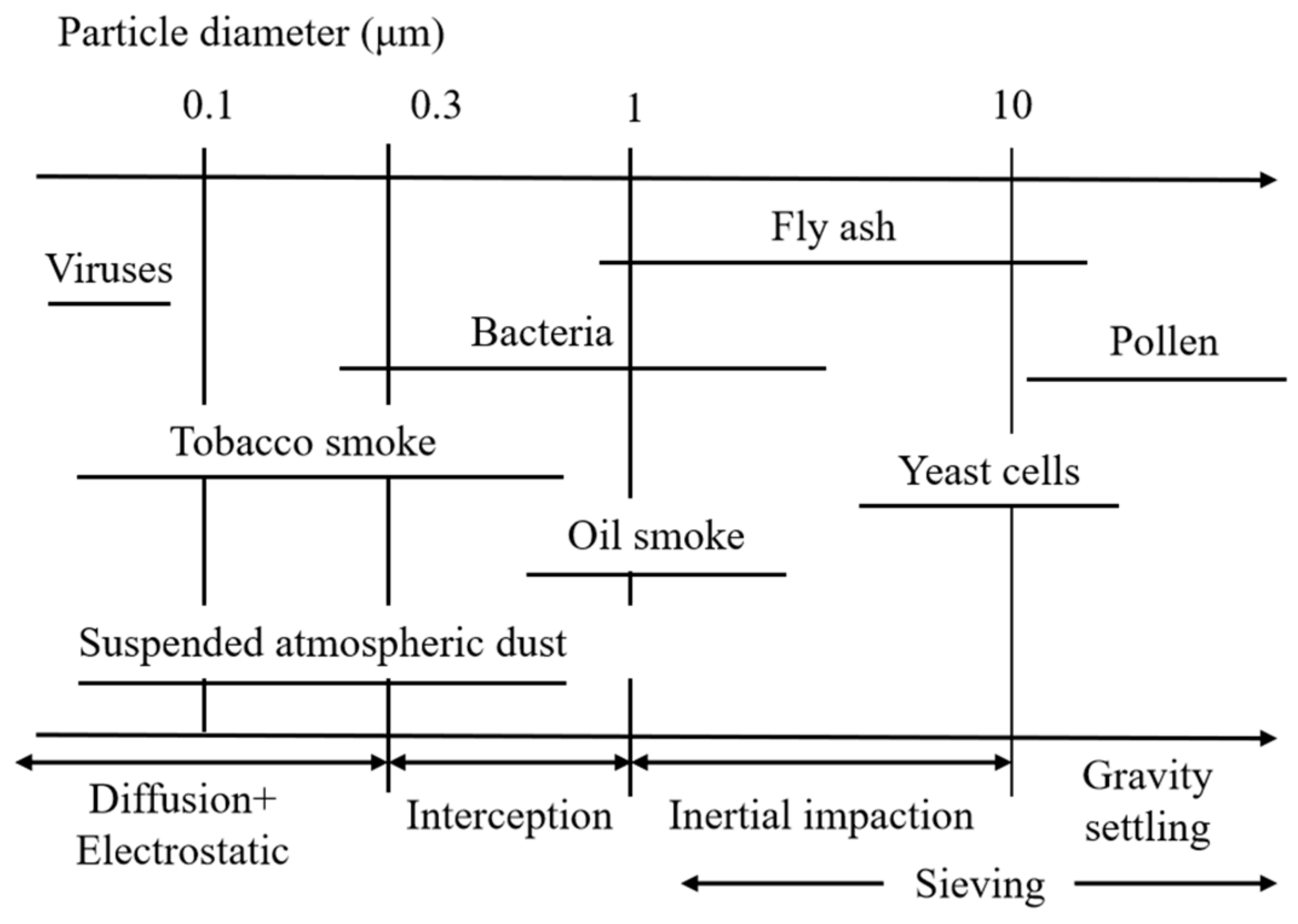
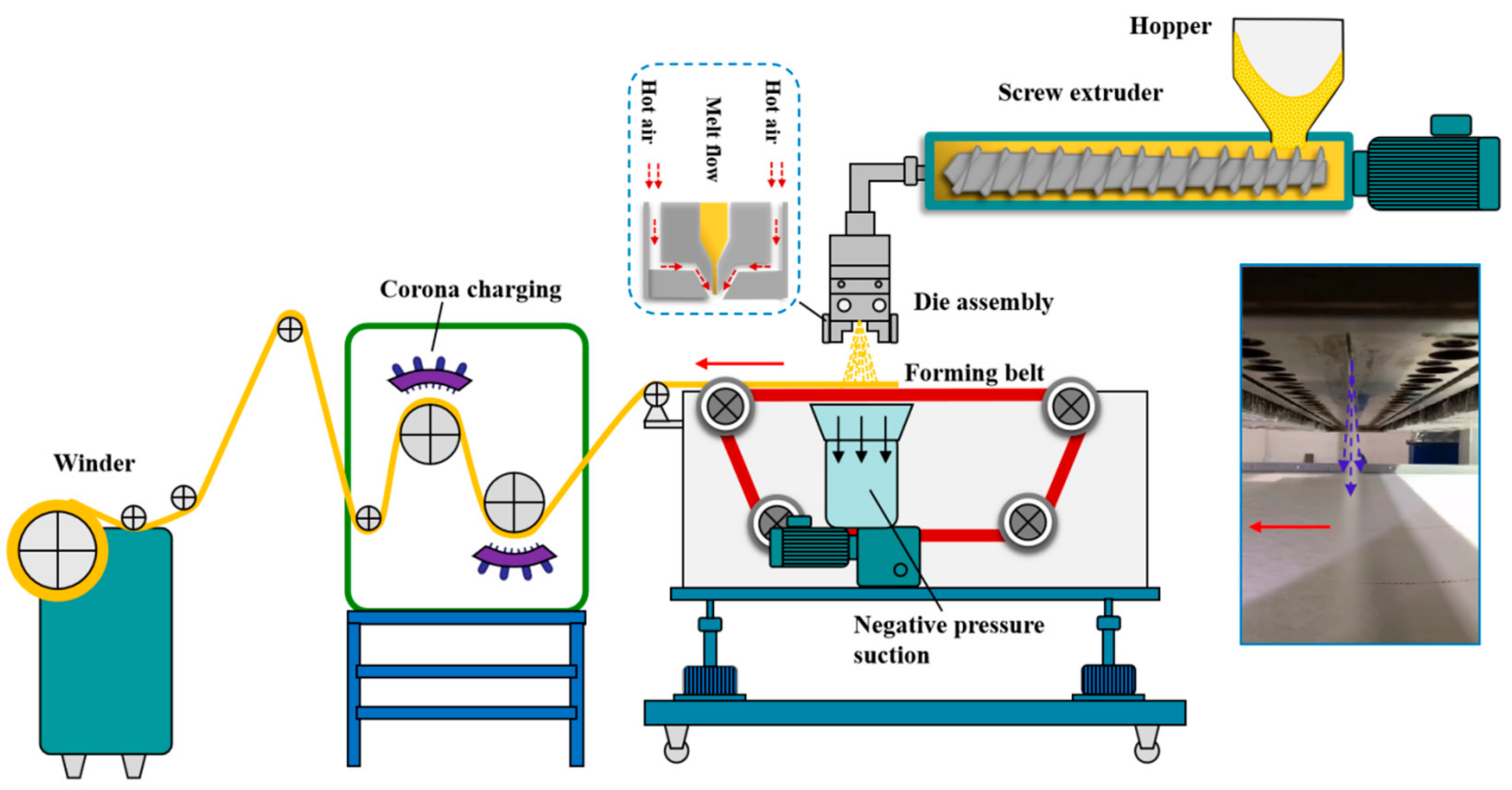
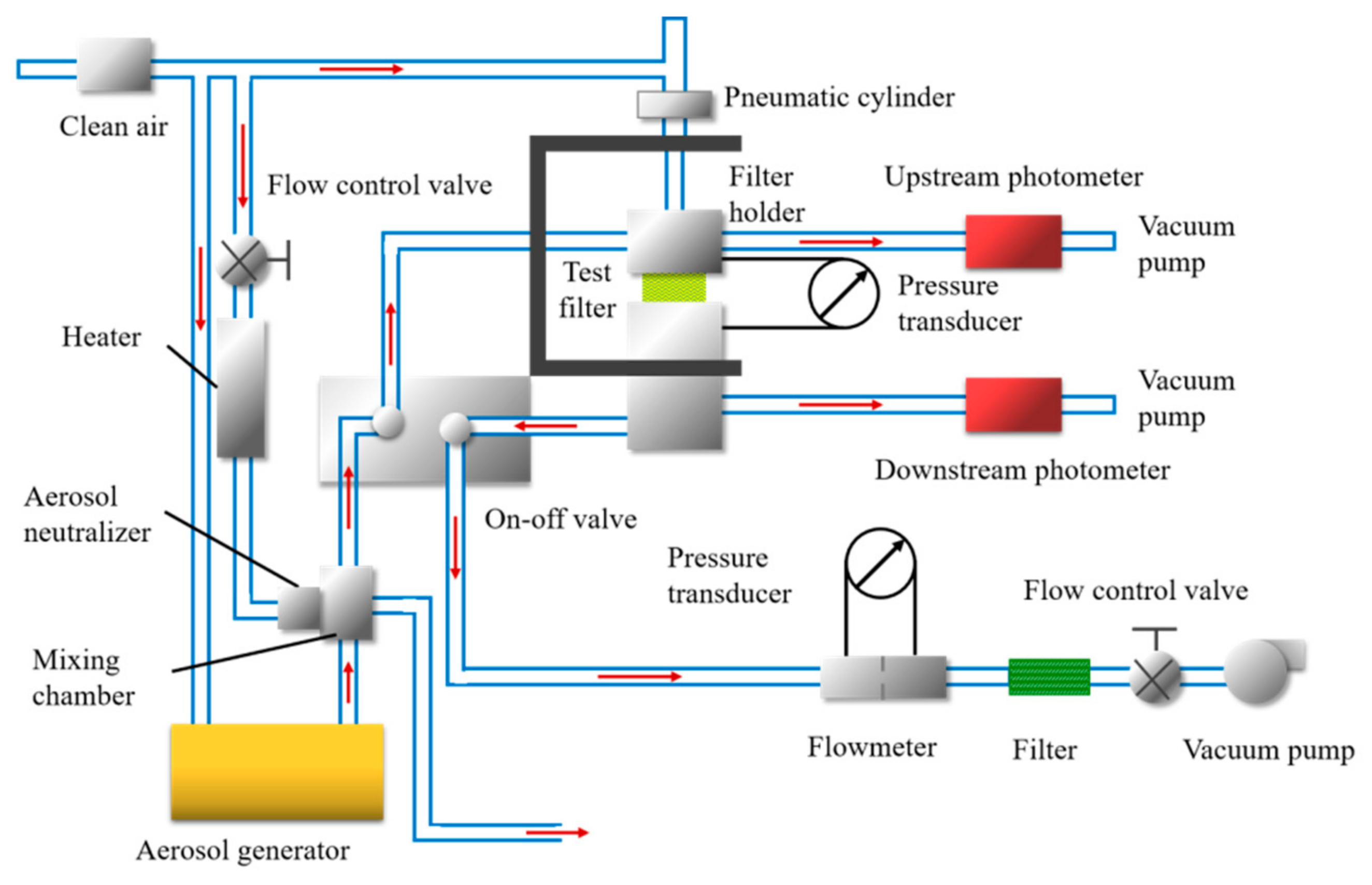
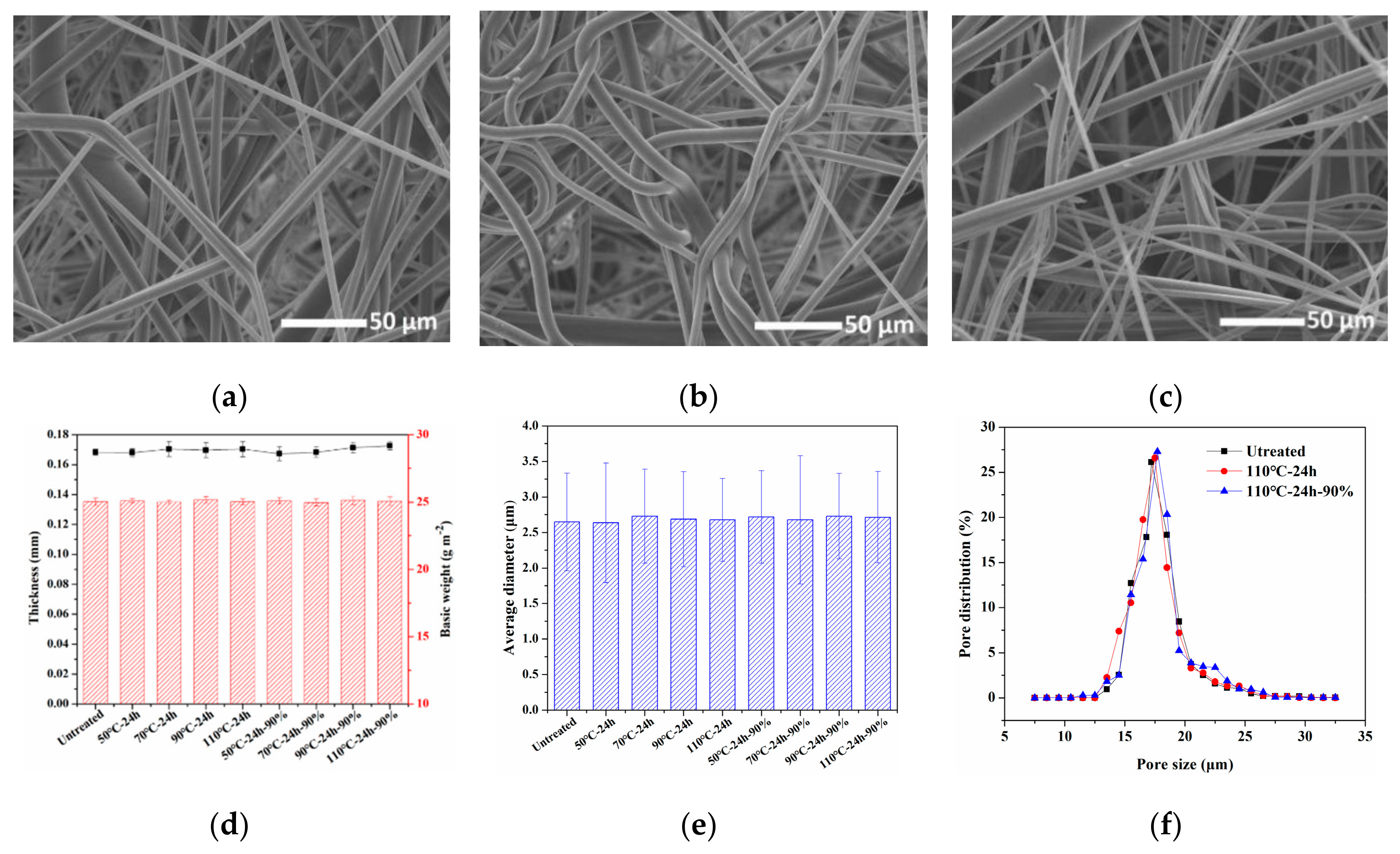

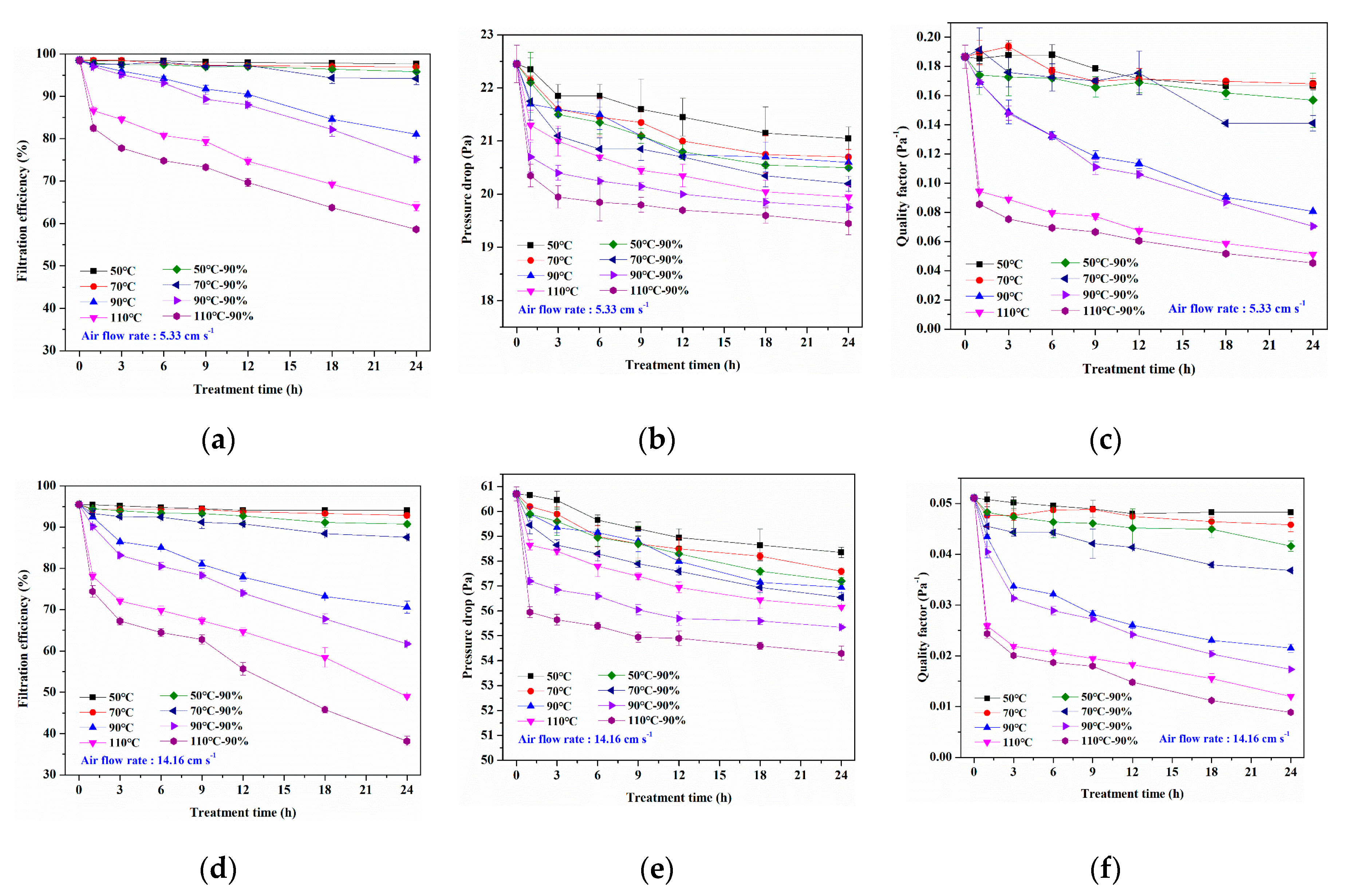
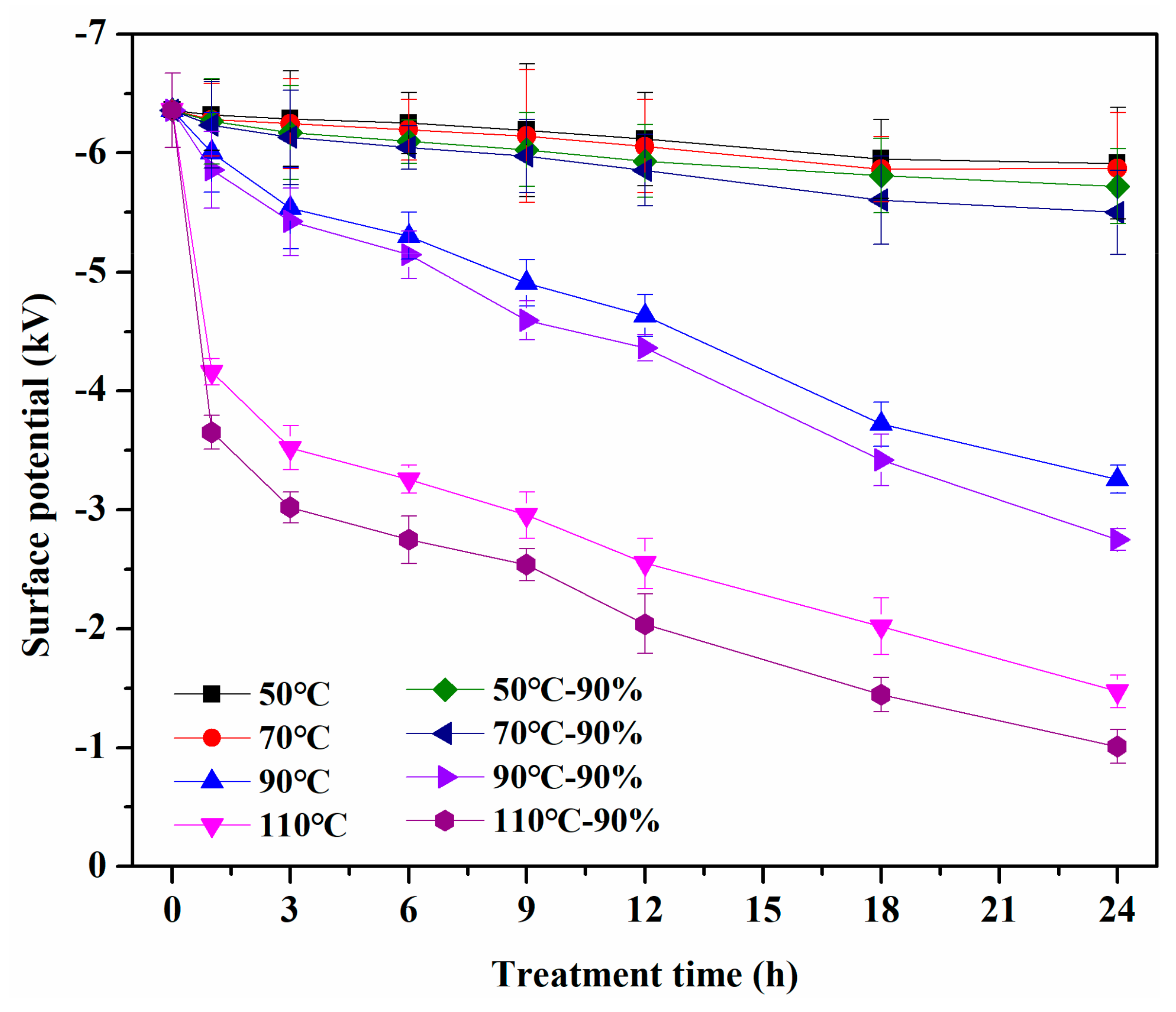
Publisher’s Note: MDPI stays neutral with regard to jurisdictional claims in published maps and institutional affiliations. |
© 2020 by the authors. Licensee MDPI, Basel, Switzerland. This article is an open access article distributed under the terms and conditions of the Creative Commons Attribution (CC BY) license (http://creativecommons.org/licenses/by/4.0/).
Share and Cite
Liu, C.; Dai, Z.; He, B.; Ke, Q.-F. The Effect of Temperature and Humidity on the Filtration Performance of Electret Melt-Blown Nonwovens. Materials 2020, 13, 4774. https://doi.org/10.3390/ma13214774
Liu C, Dai Z, He B, Ke Q-F. The Effect of Temperature and Humidity on the Filtration Performance of Electret Melt-Blown Nonwovens. Materials. 2020; 13(21):4774. https://doi.org/10.3390/ma13214774
Chicago/Turabian StyleLiu, Chao, Zijian Dai, Bin He, and Qin-Fei Ke. 2020. "The Effect of Temperature and Humidity on the Filtration Performance of Electret Melt-Blown Nonwovens" Materials 13, no. 21: 4774. https://doi.org/10.3390/ma13214774
APA StyleLiu, C., Dai, Z., He, B., & Ke, Q.-F. (2020). The Effect of Temperature and Humidity on the Filtration Performance of Electret Melt-Blown Nonwovens. Materials, 13(21), 4774. https://doi.org/10.3390/ma13214774



